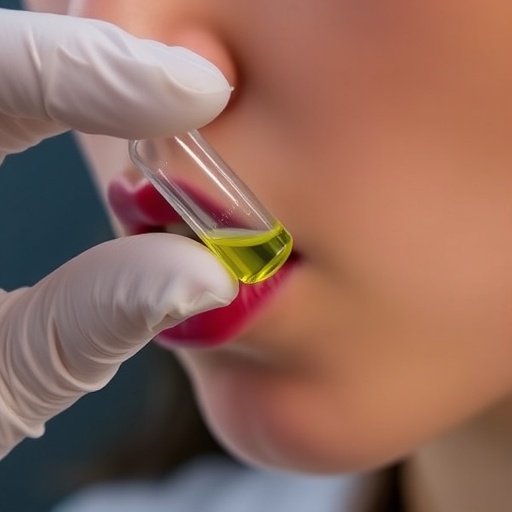A groundbreaking advancement in the early detection of psychiatric disorders has emerged from Brazilian scientific laboratories. Researchers from the University of São Paulo (USP) and Embrapa Instrumentação, an entity linked to the Brazilian Agricultural Research Corporation (Embrapa), have engineered a low-cost, portable biosensor capable of identifying the levels of a critical protein associated with mental health conditions such as depression, schizophrenia, and bipolar disorder. This innovation holds the promise to revolutionize the way psychiatric ailments are diagnosed and managed by offering a rapid and noninvasive testing solution.
This biosensor utilizes a flexible strip ingrained with electrodes designed to examine small quantities of saliva, a sample easily obtained without discomfort or invasive procedure. When this strip is connected to a portable analytical device, it can determine the concentration of brain-derived neurotrophic factor (BDNF) within less than three minutes. BDNF is a vital protein for the growth, development, and maintenance of neurons and brain function, including essential cognitive abilities like learning and memory. Alterations in the levels of this protein in the body have been closely linked to various psychiatric disorders, rendering its measurement indispensable for clinical diagnosis.
Published in ACS Polymers Au, the research underscores the biosensor’s ability to detect BDNF within an astoundingly broad range of concentrations, from 10⁻²⁰ to 10⁻¹⁰ grams per milliliter of saliva. This sensitivity level enables the detection of negligible yet clinically significant amounts of BDNF that traditional methodologies might overlook. The ability to measure such low concentrations paves the way for early warnings of psychiatric illnesses, potentially transforming patient outcomes through timely interventions.
Economically, this biosensor stands out for its affordability, with each disposable unit costing only about US$2.19 (less than 12 Brazilian reais), making it accessible for widespread use. Its design also ensures a long shelf-life, contributing to the feasibility of mass production and distribution. Following these promising developments, the research team is seeking to patent this technology, aiming for broader commercial availability and clinical adoption.
The biosensor’s functional design comprises a trio of electrodes screen-printed on a polyester film substrate: a working electrode enhanced with carbon nanospheres, a pure carbon auxiliary electrode, and a silver reference electrode. To heighten sensitivity and immobilize the BDNF-specific capture antibody, chemical layers of polyethyleneimine and glutaraldehyde were applied to the working electrode. An additional protective layer of ethanolamine avoids nonspecific interactions, ensuring that only the target protein influences the sensor’s readings.
The detection mechanism centers on the antibody-antigen immunocomplex formation at the sensor interface. When BDNF binds to its specific antibody on the electrode surface, it increases the resistance to electron transfer, a change that can be accurately quantified using electrochemical impedance spectroscopy. This technique probes the interface between electrode and sample solution, providing a powerful and precise measurement of the protein concentration in real time.
One of the most significant benefits of this biosensor lies in its integration with mobile technology. Data collected from the sensor can be transmitted wirelessly to a smartphone via Bluetooth, allowing users and healthcare providers to monitor BDNF levels conveniently and continuously outside traditional laboratory settings. This connectivity represents a leap forward towards personalized medicine, where treatments can be fine-tuned according to dynamic biochemical markers.
Currently, the detection of BDNF relies on complex, time-consuming laboratory methods such as enzyme-linked immunosorbent assay (ELISA), electrochemiluminescence, fluorescence analysis, and high-performance liquid chromatography (HPLC). These techniques require large sample volumes and sophisticated lab equipment, limiting their accessibility and frequency of use. The new biosensor circumvents these barriers by offering rapid, on-demand testing with minimal sample requirements in a portable format.
The broader implications of this innovation resonate amid the escalating global mental health crisis. According to World Health Organization data, more than one billion individuals worldwide suffer from mental disorders, with depression and anxiety topping the list of prevalent conditions. In Brazil alone, psychiatric-related workplace absences soared by over 130% between 2022 and 2024, highlighting the urgent need for accessible diagnostic tools and early intervention strategies.
Low BDNF concentrations are particularly notable markers of major depressive disorder, with patients often exhibiting levels below 10–12 nanograms per milliliter, in stark contrast to healthy individuals whose levels surpass 20 nanograms per milliliter. Monitoring these fluctuations enables clinicians to not only detect the onset of mental health issues but also track therapeutic effectiveness over time, making the sensor a dual diagnostic and treatment support device.
This project’s success is rooted in interdisciplinary collaboration encompassing chemistry, biotechnology, physical sciences, and engineering. The research team drew on expertise in flexible sensors and electrochemical techniques, building upon previous achievements such as a portable sensor for urine testing that identified biomarkers linked to gout and Parkinson’s disease. The confluence of these diverse scientific fields has culminated in an innovation with far-reaching potential for public health.
As mental health awareness grows and the paradigm shifts towards individualized treatment regimens, tools like this biosensor will become indispensable. Beyond clinical settings, its ease of use and rapid turnaround might empower patients to participate in their health management actively. This democratization of diagnosis represents a transformative step in combating the stigma and neglect often surrounding psychiatric disorders.
Looking ahead, the biosensor technology can be further refined and adapted to analyze different biomarkers relevant to various diseases, making it a versatile platform for future diagnostic applications. The backing from prominent funding bodies such as the São Paulo Research Foundation (FAPESP) fortifies the project’s trajectory towards clinical trials and eventual commercial deployment. By bridging the gap between cutting-edge science and accessible healthcare, this innovation marks a milestone in mental health diagnostics.
Subject of Research: Low-cost, disposable biosensor technology for rapid detection of brain-derived neurotrophic factor (BDNF) in saliva linked to psychiatric disorder diagnostics.
Article Title: Low-Cost, Disposable Biosensor for Detection of the Brain-Derived Neurotrophic Factor Biomarker in Noninvasively Collected Saliva toward Diagnosis of Mental Disorders
News Publication Date: 31-Jul-2025
Web References:
– https://pubs.acs.org/doi/10.1021/acspolymersau.5c00038
– https://bv.fapesp.br/en/pesquisador/79299/
– https://iris.who.int/bitstream/handle/10665/382452/9789240114487-eng.pdf
References:
– Publication in ACS Polymers Au journal, DOI: 10.1021/acspolymersau.5c00038
Image Credits:
Illustration by Amanda H. Imamura/Sci Illustrations
Keywords:
Sensors, Mental Health, Biotechnology, Chemistry




